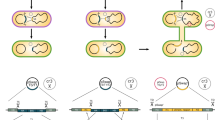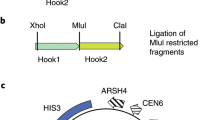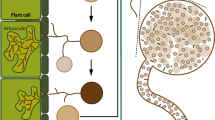Abstract
Megabase-sized DNA is crucial to modern genomics research of all organisms. Among the preparation methods developed, the nuclei method is the simplest and most widely used for preparing high-quality megabase-sized DNA from divergent organisms. In this method, nuclei are first isolated by physically grinding the source tissues. The nontarget cytoplast organellar genomes and metabolites are removed by centrifugation and washing, thus maximizing the utility of the method and substantially improving the digestibility and clonability of the resultant DNA. The nuclei are then embedded in an agarose matrix containing numerous pores, allowing the access of restriction enzymes while preventing the DNA from physical shearing. DNA is extracted from the nuclei, purified and subsequently manipulated in the agarose matrix. Here we describe the nuclei method that we have successfully used to prepare high-quality megabase-sized DNA from hundreds of plant, animal, fish, insect, algal and microbial species. The entire protocol takes ∼3 d.
This is a preview of subscription content, access via your institution
Access options
Subscribe to this journal
Receive 12 print issues and online access
$259.00 per year
only $21.58 per issue
Buy this article
- Purchase on Springer Link
- Instant access to full article PDF
Prices may be subject to local taxes which are calculated during checkout


Similar content being viewed by others
References
Zhang, H.-B., Woo, S.-S. & Wing, R.A. BAC, YAC and cosmid library construction. in Plant Gene Isolation: Principles and Practice (eds. Foster, G. & Twell, D.) 75–99 (John Wiley & Sons, 1996).
Schwartz, D.C. & Cantor, C.R. Separation of yeast chromosome-sized DNAs by pulsed-field gradient gel electrophoresis. Cell 37, 67–75 (1984).
Ganal, M.W. & Tanksley, S.D. Analysis of tomato DNA by pulsed-field gel electrophoresis. Plant Mol. Biol. Rep. 7, 17–27 (1989).
Overhauser, J. & Radic, M.Z. Encapsulation of cells in agarose beads for use with pulsed-field gel electrophoresis. Focus 9.3, 8–9 (1987).
van Daelen, R.A.J., Jonkers, J.J. & Zabel, P. Preparation of megabase-sized tomato DNA and separation of large restriction fragments by field inversion gel electrophoresis (FIGE). Plant Mol. Biol. 12, 341–352 (1989).
Fierro, F., Gutierrez, S., Diez, B. & Martin, J.F. Resolution of four large chromosomes in penicillin-producing filamentous fungi: the penicillin gene cluster is located on chromosome II (9.6 Mb) in Penicillin notatum and chromosome I (10.4 Mb) in Penicillin chrysogenum. Mol. Gen. Genet. 241, 573–578 (1993).
Zhang, H.-B., Zhao, X.-P., Ding, X.-L., Paterson, A.H. & Wing, R.A. Preparation of megabase-size DNA from plant nuclei. Plant J. 7, 175–184 (1995).
Xu, Z. et al. Genome-wide physical mapping from large-insert clones by fingerprint analysis with capillary electrophoresis: a robust physical map of Penicillium chrysogenum. Nucleic Acids Res. 33, e50 (2005).
Shizuya, H. et al. Cloning and stable maintenance of 300-kilobase-pair fragments of human DNA in Escherichia coli using an F-factor-based vector. Proc. Natl. Acad. Sci. USA 89, 8794–8797 (1992).
Ioannou, P.A. et al. A new bacteriophage P1-derived vector for the propagation of large human DNA fragments. Nat. Genet. 6, 84–89 (1994).
Kim, U.-J. et al. Construction and characterization of a human bacterial artificial chromosome library. Genomics 34, 213–218 (1996).
Tao, Q.-Z. & Zhang, H.-B. Cloning and stable maintenance of DNA fragments over 300 kb in Escherichia coli with conventional plasmid-based vectors. Nucleic Acids Res. 26, 4901–4909 (1998).
Wu, C., Xu, Z. & Zhang, H.-B. DNA libraries. in Encyclopedia of Molecular Cell Biology and Molecular Medicine 2nd edn., Vol 3 (ed. Meyers, R.A.) 385–425 (Wiley-VCH, 2004).
Hamilton, C.M., Frary, A., Lewis, C. & Tanksley, S.D. Stable transfer of intact high molecular weight DNA into plant chromosomes. Proc. Natl. Acad. Sci. USA 93, 9975–9979 (1996).
Liu, Y. et al. Complementation of plant mutants with large genomic DNA fragments by a transformation-competent artificial chromosome vector accelerates positional cloning. Proc. Natl. Acad. Sci. USA 96, 6535–6540 (1999).
Burke, D.T., Carle, G.F. & Olson, M.V. Cloning of large segments of exogenous DNA into yeast by means of artificial chromosome vectors. Science 236, 806–811 (1987).
Wing, R.A., Zhang, H.-B. & Tanksley, S.D. Map-based cloning in crop plants: tomato as a model system I. Genetic and physical mapping of jointless. Mol. Gen. Genet. 242, 681–688 (1994).
Wing, R.A., Rastogi, V.K., Zhang, H.-B., Paterson, A.H. & Tanksley, S.D. An improved method of plant megabase DNA isolation in agarose microbeads suitable for physical mapping and YAC cloning. Plant J. 4, 893–898 (1993).
Woo, S.-S., Rastogi, V.K., Zhang, H.-B., Paterson, A.H. & Wing, R.A. Isolation of megabase size DNA from sorghum and applications for physical mapping and yeast and bacterial artificial chromosome library construction. Plant Mol. Biol. Rep. 13, 38–50 (1995).
Page, K. & Shaw, J.A. Isolation of nucleic acids from body fluids. in Handbook of Nucleic Acid Purification (ed. Liu, D.) 381–403 (CRC Press Taylor & Francis Group, 2009).
Song, W. & Liu, D. Isolation of nucleic acids from plants. in Handbook of Nucleic Acid Purification (ed. Liu, D.) 503–520 (CRC Press Taylor & Francis Group, 2009).
Zhang, H.-B., Choi, S.-D., Woo, S.-S., Li, Z.-K. & Wing, R.A. Construction and characterization of two rice bacterial artificial chromosome libraries from the parents of a permanent recombinant inbred mapping population. Mol. Breed 2, 11–24 (1996).
Lee, M.-K. et al. Construction and characterization of three complementary BAC libraries for analysis of the chicken genome. Anim. Genet. 34, 151–152 (2003).
Zhang, H.-B. Map-based cloning of genes and quantitative trait loci. in Principles and Practices of Plant Genomics Vol. 1, Genome Mapping (eds. Kole, C. & Abbott A.G.) 229–267 (Science Publishers, 2007).
Gregory, S.G., Howell, G.R. & Bentley, D.R. Genome mapping by fluorescent fingerprinting. Genome Res. 7, 1162–1168 (1997).
Marra, M. et al. High throughput fingerprint analysis of large-insert clones. Genome Res. 7, 1072–1084 (1997).
Zhang, H.-B. & Wing, R.A. Physical mapping of the rice genome with BACs. Plant Mol. Biol. 35, 115–127 (1997).
Wu, C. et al. Whole genome physical mapping: an overview on methods for DNA fingerprinting. in Handbook of Plant Genome Mapping: Genetic and Physical Mapping (eds. Meksem, K. & Kahl, G.) 257–184 (Wiley-VCH, 2005).
Chang, Y.-L., Tao, Q.-Z., Scheuring, C., Meksem, K. & Zhang, H.-B. An integrated map of Arabidopsis thaliana for functional analysis of its genome sequence. Genetics 159, 1231–1242 (2001).
Tao, Q.-Z. et al. Bacterial artificial chromosome-based physical map of the rice genome constructed by restriction fingerprint analysis. Genetics 158, 1711–1724 (2001).
Zhang, Y. et al. A comparative physical map reveals the pattern of chromosomal evolution between the turkey (Meleagris gallopavo) and chicken (Gallus gallus) genomes. BMC Genomics 12, 447 (2011).
Venter, J.C., Smith, H.O. & Hood, L. A new strategy for genome sequencing. Nature 381, 364–366 (1996).
Zhang, H.-B. & Wu, C.C. BACs as tools for genome sequencing. Plant Physiol. Biochem. 39, 195–209 (2001).
International Human Genome Sequencing Consortium. Initial sequencing and analysis of the human genome. Nature 409, 860–921 (2001).
International Rice Genome Sequencing Project. The map-based sequence of the rice genome. Nature 436, 793–800 (2005).
Schnable, P.S. et al. The B73 maize genome: complexity, diversity, and dynamics. Science 326, 1112–1115 (2009).
Steuernagel, B. et al. De novo 454 sequencing of barcoded BAC pools for comprehensive gene survey and genome analysis in the complex genome of barley. BMC Genomics 10, 247 (2009).
Sato, K., Motoi, Y., Yamaji, N. & Yoshida, H. 454 sequencing of pooled BAC clones on chromosome 3H of barley. BMC Genomics 12, 246 (2011).
Tyler, B.M. et al. Phytophthora genome sequences uncover evolutionary origins and mechanisms of pathogenesis. Science 313, 1261–1266 (2006).
Dalloul, R.A. et al. Multi-platform next generation sequencing of the domestic turkey (Meleagris gallopavo): genome assembly and analysis. PLoS Biol. 8, e1000475 (2010).
Song, R., Segal, G. & Messing, J. Expression of the sorghum 10-member kafirin gene cluster in maize endosperm. Nucleic Acids Res. 32, e189 (2004).
Chang, Y.-L. et al. A plant-transformation-ready large-insert BIBAC library of Arabidopsis and bombardment transformation and expression of its large-insert BIBACs in tobacco. Genome 54, 437–447 (2011).
Hong, Y.S. et al. Construction and characterization of a BAC library and generation of BAC end sequence-tagged connectors for genome sequencing of the malaria mosquito, Anopheles gambiae. Mol. Genet. Genomics 268, 720–728 (2003).
Wu, C. et al. Construction and sequence sampling of deep-coverage, large-insert BAC libraries for three model Lepidopteran species. BMC Genomics 10, 283 (2009).
Zhang, Y. et al. Construction and characterization of two bacterial artificial chromosome libraries of Zhikong Scallop, Chlamys farreri Jones et Preston, and identification of BAC clones containing the genes involved in its innate immune system. Mar. Biotechnol. 10, 358–365 (2008).
Zhang, X. et al. Construction and characterization of a bacterial artificial chromosome (BAC) library of pacific white shrimp, Liptopenaeus vannamei. Mar. Biotechnol. 12, 141–149 (2010).
Shao, C.-W. et al. Construction of two BAC libraries of half-smooth tongue sole Cynoglossus semilaevis and isolation of clones containing candidate sex-determination genes. Mar. Biotechnol. 12, 558–568 (2010).
Hume, M.E. et al. Genotypic variation among Arcobacter isolates from a farrow-to-finish swine facility. J. Food Prot. 64, 645–651 (2001).
Ren, C. et al. A BAC-based physical map of the chicken genome. Genome Res. 13, 2754–2758 (2003).
Wu, C. et al. A BAC and BIBAC-based physical map of the soybean genome. Genome Res. 14, 319–326 (2004).
Zhang, X. et al. An integrated BAC and genome sequence physical map of Phytophthora sojae. Mol. Plant Microbe Interact. 19, 1302–1310 (2006).
Li, Y. et al. A plant-transformation-competent BIBAC/BAC-based map of rice for functional analysis and genetic engineering of its genomic sequence. Genome 50, 278–288 (2007).
Zhang, X. et al. A BAC/BIBAC-based physical map of chickpea, Cicer arietinum L. BMC Genomics 11, 501 (2010).
Zhao, X.-P., Zhang, H.-B., Wing, R.A. & Paterson, A.H. A simple method for cotton megabase DNA isolation. Plant Mol. Biol. Rep. 12, 126–131 (1994).
Zhang, H.-B. et al. Construction of BIBAC and BAC libraries from a variety of organisms for advanced genomics research. Nat. Protoc. 7, 479–499 (2012).
Ren, C. et al. Genomic DNA libraries and physical mapping. in Handbook of Plant Genome Mapping: Genetic and Physical Mapping (eds. Meksem, K. & Kahl, G.) 173–213 (Wiley-VCH, 2005).
Acknowledgements
We thank the former members of H.-B.Z.'s laboratory who have used the protocols described in this article for their research and thus might have directly or indirectly contributed to the protocol. This work is supported in part by Research Grant Award no. IS-4427-11C from BARD, the United States-Israel Binational Agricultural Research and Development Fund (H.-B.Z.) and grants (124475-85360 and 124329-85360) from the Texas AgriLife Research Cotton and Monocot Crop Improvement Program (H.-B.Z.).
Author information
Authors and Affiliations
Contributions
M.P.Z., Y.Z., C.F.S., C.-C.W., J.J.D. and H.-B.Z. conducted the experiments on different species with the protocol presented here, and improved and extended the original protocol through these experiments. M.P.Z. wrote the manuscript; H.-B.Z. developed the original concept of the protocol and the original protocol, designed the experiments and wrote the manuscript.
Corresponding author
Ethics declarations
Competing interests
The authors declare no competing financial interests.
Rights and permissions
About this article
Cite this article
Zhang, M., Zhang, Y., Scheuring, C. et al. Preparation of megabase-sized DNA from a variety of organisms using the nuclei method for advanced genomics research. Nat Protoc 7, 467–478 (2012). https://doi.org/10.1038/nprot.2011.455
Published:
Issue Date:
DOI: https://doi.org/10.1038/nprot.2011.455
This article is cited by
-
The first high-quality genome assembly and annotation of Patiria pectinifera
Scientific Data (2023)
-
A complete telomere-to-telomere assembly of the maize genome
Nature Genetics (2023)
-
An improved Raphanus sativus cv. WK10039 genome localizes centromeres, uncovers variation of DNA methylation and resolves arrangement of the ancestral Brassica genome blocks in radish chromosomes
Theoretical and Applied Genetics (2022)
-
Consistent ultra-long DNA sequencing with automated slow pipetting
BMC Genomics (2021)
-
Chromosome-level genome assembly of a regenerable maize inbred line A188
Genome Biology (2021)
Comments
By submitting a comment you agree to abide by our Terms and Community Guidelines. If you find something abusive or that does not comply with our terms or guidelines please flag it as inappropriate.



